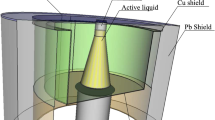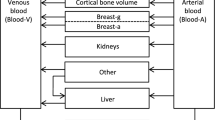Abstract
The radon exhalation rate and transfer radon velocity between liquid and gas under different temperature and humidity conditions are investigated. The fitting formulas of radon exhalation rate and temperature and humidity are exponential functions, and each exponent is a 2nd-order polynomial. The fitting formula of transfer radon velocity and temperature is Boltzmann function, and the velocity tends to be stable gradually at 25 °C. The fitting formula of transfer radon velocity and humidity is exponential function whose exponent is a 2nd order polynomial, and the velocity increases at first when the humidity was 0.75, then decreases with increasing humidity.








Similar content being viewed by others
References
Neretnieks I (2013) Some aspects of release and transport of gases in deep granitic rocks: possible implications for nuclear waste repositories. Hydrogeol J 21(8):1701–1716
Moldrup P, Olesen T, Komatsu T, Schjonning P, Rolston DE (2001) The Tortuosity, diffusivity, and permeability in the soil liquid and gaseous phases. Soil Sci Soc Am J 65(3):613–623
Manoharan S, Sudhakaran S, Williamson TH (2011) Air-gas exchange reevaluated: clinically important results of a computer simulation. Invest Ophthalmic Vis Sci 52(11):8262–8263
Ongori JN, Lindsay R, Mvelase MJ (2015) Radon transfer velocity at the water–air interface. Appl Radiat Isotopes 105:144–149. https://doi.org/10.1016/j.apradiso.2015.07.058
Luis SQP, Carlos SF, Ismael FM, Jose LGV, Alberto GD (2013) The use of radon as tracer in environmental sciences. Acta Geophys 61(4):848–858
Papp B, Deák F, Horváth Á, Kiss Á, Rajnai G, Cs S (2008) A new method for the determination of geophysical parameters by radon concentration measurements in bore-hole. J Environ Radioact 99(11):1731–1735
Waska H, Kim S, Kim G, Peterson RN, Burnett WC (2008) An efficient and simple method for measuring 226Ra using the scintillation cell in a delayed coincidence counting system (RaDeCC). J Environ Radioact 99(12):1859–1862
Burnett WC, Peterson RN, Santos IR, Hicks RW (2010) Use of automated radon measurements for rapid assessment of groundwater flow into Florida streams. J Hydrol 380(3–4):298–304
Savoy L, Surbeck H, Hunkeler D (2011) Radon and CO2 as natural tracers to investigate the recharge dynamics of karst aquifers. J Hydrol 406(3):148–157
Stellato L, Terrasi F, Marzaioli F, Belli M, Sansone U, Celico F (2013) Is 222Rn a suitable tracer of stream-groundwater interactions? A case study from Italy. Appl Geochem 32(2013):108–117
Nasab SMM, Negarestani A, Mohammadi S (2011) Modeling of the radon exhalation from water to air by a hybrid electrical circuit. J Radioannal Nucl Chem 288(3):813–818
Schmidt A, Schlueter M, Melles M, Schubert M (2008) Continuous and discrete on-site detection of radon-222 in ground-and surface waters by means of an extraction module. Appl Radiat Isotopes 66(12):1939–1944
Sahoo BK, Mayya YS, Sapra BK (2010) Radon exhalation studies in an Indian uranium tailings pile. Radiat Meas 45(2):237–241
Kumar A, Chauhan RP, Joshi M (2014) Modeling of indoor radon concentration from radon exhalation rates of building materials and validation through measurements. J Environ Radioact 127(2):50–55
Sundar SB, Chitra N, Vijayalakshmi I, Danalakshmi B, Chandrasekaran S, Jose MT, Venkatraman B (2015) Soil radioactivity measurements and estimation of radon/thoron exhalation rate in soil samples from Kalpakkam residential complex. Radiat Prot Dosim 164(4):569–574
Schubert M, Schulz H (2002) Diurnal radon variations in the upper soil layers and at the soil-air interface related to meteorological parameters. Health Phys 83(1):91–96
Iakovleva VS, Ryzhakova NK (2003) Spatial and temporal varitions of radon concentration in soil air. Radiat Meas 36(1–6):385–388
Sundal AV, Valen V, Soldal O, Strand T (2008) The influence of meteorological parameters on soil radon levels in permeable glacial sediments. Sci Total Environ 389(2–3):418–428
Smetanová I, Holý K, Müllerová M, Polášková A (2010) The effect of meteorological parameters on radon concentration in borehole air and water. J Radioannal Nucl Chem 283(1):101–109
Kasztovszky Z, Sajó-Bohus L, Fazekas B (2000) Parameric changes of radon (222Rn) concentration in ground water in Northeastern Hungary. J Environ Radioact 49(2):171–180
Wanninkhof R, Asher WE, Ho DT, Sweeney C, Mcgillis WR (2009) Advances in quantifying air-sea gas exchange and environmental forcing. Annu Rev Mar Sci 1(1):213–244
Chanyotha S, Kranrod C, Burnett WC (2014) Assessing diffusive fluxes and pore water radon activities via a single automated experiment. J Radioannal Nucl Chem 301(2):581–588
Monnin MM, Seidel JL (1997) Physical models related to radon emission in connection with dynamic manifestations in the upper terrestrial crust: a review. Radiat Meas 28(97):703–712
Schubert M, Paschke A, Lieberman E, Burnett WC (2012) Air-water partitioning of 222Rn and its dependence on water temperature and salinity. Environ Sci Technol 46(7):3905–3911
Rogers VC, Nielson KK (1991) Correlations for predicting air permeabilities and radon-222 diffusion coefficients of soils. Health Phys 61(2):225–230
Rogers VC, Nielson KK (1991) Multiphase radon generation and transport in porous materials. Health Phys 60(6):807–815
Dulaiova H, Burnett WC (2006) Radon loss across the water-air interface (Gulf of Thailand) estimated experimentally from 222Rn–224Ra. Geophys Res Lett 33(5):L05606
Weigel F (1978) Radon Chem Ztg 102:287–299
Lee JM, Kim G (2006) A simple and rapid method for analyzing radon in coastal and ground waters using a radon-in-air monitor. J Environ Radioact 89(3):219–228
He ZZ, Xiao DT, Zhao GZ, Qiu SK, Shan J, Fu Y, OuYang Q, Wu XJ (2013) theoretical calculation and experimental determination of iterative correction factor for continuous measurement radon method. At Energy Sci Technol (China) 6(47):1040–1043
The Commission of Science, Technology and Industry for National Defense of the PRC (2001) EJ/T 1133-2001 Regulations for measurement of radon in water. China Nuclear Industry Standard: 3–8
Saâdi Z (2014) On the air-filled effective porosity parameter of rogers and nielson’s (1991) bulk radon diffusion coefficient in unsaturated soils. Health Phys 106(5):598–607
Calugaru DG, Crolet JM (2002) Identification of radon transfer velocity coefficient between liquid and gaseous phases. Cr Mec 330(5):377–382
Baskaran M (2016) Radon: a tracer for geological, geophysical and geochemical studies. Geochemistry. Springer, Berlin. https://doi.org/10.1007/978-3-319-21329-3
Schubert M, Paschke A, Bednorz D, Burkin W, Stieglitz T (2012) Kinetics of the water/air phase transition of radon and its implication on detection of radon-in-water concentrations: practical assessment of different on-site radon extraction methods. Environ Sci Technol 46(16):8945–8951
Acknowledgements
The authors thank Mr. Yongjun Yan for his advice in preparing the manuscript, especially regarding data processing.
Author information
Authors and Affiliations
Corresponding author
Rights and permissions
About this article
Cite this article
Zhou, J., Ding, D. & Ye, J. Study on the influence of temperature and humidity on radon exhalation from a radon-containing solution. J Radioanal Nucl Chem 318, 1099–1107 (2018). https://doi.org/10.1007/s10967-018-6224-3
Received:
Published:
Issue Date:
DOI: https://doi.org/10.1007/s10967-018-6224-3




